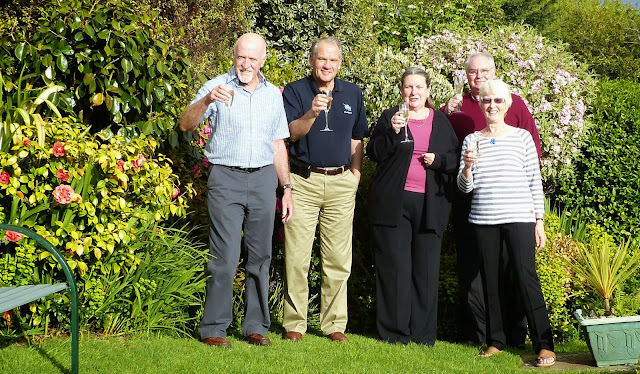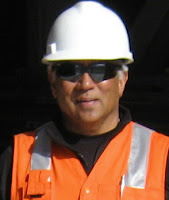The 2-day conference was dedicated to the University of Cambridge's Professor Derek Fray to mark his life-time contributions to, and achievements in, minerals processing and extractive metallurgy.
The conference was opened on Tuesday morning by Tony Francis, of Francis Minerals Consulting Ltd, UK, the Chairman of the Organising Committee, and Vasant Kumar of the University of Cambridge, who welcomed the 80 delegates from 18 countries to the historic Trinity Hall, founded in the 14th century, and boasting Prof. Stephen Hawking amongst its illustrious alumni.
 |
| Trinity Hall |
 |
| Tony Francis, Derek Fray and Vasant Kumar |
Appropriately Derek Fray presented the first keynote lecture at the conference, giving examples of technology transfer in metallurgy and materials science. There is an increasing encouragement for Universities to transfer their knowledge to existing companies or to create spin-out companies. However, he stressed that it is important for academics to be aware that they really have to let go of the project, or at least share it, as most academics do not have the time nor all the skills necessary to make the project a commercial success.
Frances Perry of IOM3 asked an interesting question, as to whether the
IMMAGE Database is a 20th century anachronism or a 21st century research tool.
IMMAGE (Information on Mining, Metallurgy and Geological Exploration) has for more than three decades provided subscribers and IMM/IOM3 members with focused access to the world-wide literature on mineral deposits, mining, mineral processing and extractive metallurgy. She asked, and I am sure that she would like views on this, whether now that the full text of so many periodicals and conference papers is directly accessible via the Web, there is still a place for a specialised bibliographic database providing only a technical abstract and reference to the back-up library copy. Frances showed that it is when large new projects are being undertaken, or a major technical challenge tackled, over a period of months, involving IOM3 staff being asked to search the database for a client, that its usefulness is brought home to the providers of IMMAGE.
It was good to see my old Camborne School of Mines (CSM) student
Dave Meadows again. I saw him last at the
SAG '15 conference in Vancouver in September. Dave graduated in 1985, and is now with Bechtel in USA. He presented a paper in the first morning on recent industry trends and developments in concentrator designs, making use also of his long involvement with FLSmidth.
Dave was one of four of my students from CSM days.
Yun Tai Man, of Jacobs, UK, graduated in 1992 and she presented a paper on the flotation of pyrrhotite to produce magnetite concentrates. It was also good to see Cornwall's
Nick Wilshaw, of
Comminution '16 sponsor Grinding Solutions, presenting a poster on the CEEC Energy Curve, which we will hear more of in Cape Town in April. Nick is a 1980 graduate of CSM and his company is a
CEEC advocate. Also in the photo below is
Ian Jackson of Amec Foster Wheeler UK) who graduated from CSM in 1987.
 |
| With Dave Meadows, Ian Jackson, Yun Tai Man and Nick Wilshaw |
 |
| Dave Meadows and Derek Barratt |
Derek Barratt of DJB Consultants had travelled from Vancouver just to attend this meeting. I last saw him at the
SAG '15 conference, and following Dave Meadows' presentation he gave a paper giving some reasons why large tonnage SAG circuits do not meet initial production targets.
What should have been a 75 minute lunch break, giving delegates time to network, turned out to be a rushed 30 minute break, due to certain authors feeling that 15 minutes was nowhere near adequate enough for their presentations. Nevertheless IOM3 must be commended on an excellent light lunch in a superb setting.
 |
| Lunch in an historic setting |
Following lunch the second keynote of the day was given by
Barrie Johnson. Barrie leads an renowned biotechnology team at Bangor University, which has 5 papers already submitted to next year's
Biohydromet '16 conference in Falmouth. He discussed the current status and future prospects for extracting and recovering metals from mineral ores and waste by biotechnology, which is at present a niche technology. However, Barrie described some of the more recent innovations in mineral biotechnologies, some potentially controversial, that offer the opportunities for using microbiological-based approaches in future mining and metal recycling operations, and which will have smaller carbon and energy demands and land area footprints than conventional metal mining. A lot to look forward to in Falmouth in June!
 |
| Anita with Barrie Johnson |
Barrie's keynote was "my talk of the day" tweeted Anita Parbhakar-Fox, who had travelled all the way from the University of Tasmania to present her paper on the microanalytical characterisation of historic mine waste rock, tailings, gossan waste and slag materials to assist in determining whether there are economic benefits in reprocessing such materials using modern metallurgical practices.
The Sidney Sussex College provided another wonderful venue, for the Tuesday evening conference dinner, good food and company again honouring Prof. Derek Fray.
The short morning walk from my hotel to Trinity Hall was a wonderful stroll through history, with echoes of great alumni such as Sir Isaac Newton, and the final day's session started a little later than on the Tuesday, to allow delegates to recover from any previous evening excesses!
It was good to see a strong representation from Cornwall at the conference, reflecting the diverse mineral processing activities within the remote county.
David Goldburn of sponsor SGS Services, based at the Wheal Jane mine site (
posting of 31 August) opened the day with a keynote discussing the importance of understanding ore mineralogy and mineral texture from a metallurgical perspective. He highlighted the importance of a geometallurgical approach where deposits are considered in terms of their impact and feasibility from both the macro and micro scale, set within the context of downstream processing.
Ben Tordoff of sponsor Carl Zeiss also stressed that minerals, not elements, control processing behaviour, therefore early and appropriate characterisation in the mining lifecycle will add significant value to an operation. Automated Mineralogy is one of the primary tools used in such work.
Process Mineralogy '17 sponsors Zeiss and Redruth-based Petrolab have a very strong association, as Petrolab recently acquired a Zeiss Mineralogic Mining automated mineralogy system (
posting of 10th September). Petrolab Director
James Strongman presented a paper this morning, co-authored with colleague
Jake Harrison and
Ben Tordoff of Zeiss, on a method for profiling magnetic and gravity response of metalliferous ore using Mineralogic Mining data.
 |
John Monhemius, of Anglo Asian Mining, UK, with James Strongman,
Ben Tordoff, Al Cropp (Zeiss) and Jake Harrison |
 |
| Hylke Glass and Luke Palmer |
The majority of the Cornish contingent had links to the Camborne School of Mines, represented by Prof. Hylke Glass, a member of the conference organising committee, and his student Luke Palmer, who presented a paper on the ore characterisation of perlite for process optimisation.
 |
| Mari with Barbara Wills |
Mari Lundstörm of Aalto University, Finland presented an interesting afternoon keynote on the role of chlorination in cyanide free gold leaching. Currently all gold ore leaching plants, excluding one thiosulphate plant, operate in cyanide media. Due to environmental and health and safety issues related to the use of cyanide there is currently intensive research into alternative lixiviants such as chloride, chlorine gas being used for gold oxidation in the 19th century, until cyanide took over in the 1900s. Mari described a study into the possible use of chlorination pre-treatment for preg-robbing prevention in gold chloride leaching.
Rare earth elements are increasingly in demand globally for both critical and strategic use in most high-tech gadgets, wind-turbines, hybrid vehicles etc. but their separation into pure forms is technologically challenging. In the penultimate presentation of the conference, Dhruva Singh, of Bhabha Atomic research Centre, India discussed these challenges, including the recovery of REEs from diverse resources including the recycling of e-wastes.
This has been an interesting conference, with a good group of people. A pity, however, that the coffee and lunch breaks were so short, exacerbated by sessions seriously over-running their allotted times, which limited the opportunities for networking. Nevertheless I greatly enjoyed the two days in Cambridge and congratulate IOM3 on the choice of venue. This report by no means covers everything, so I invite all who attended to add their own views and comments, either directly to this posting, or indirectly to me, bwills@min-eng.com (Twitter @barrywills).
 Delegates representing a variety of disciplines, ages, nationalities (including 4 different continents) and experience were all challenged to engage with process mineralogy from a ‘new perspective’. This is the 10th anniversary of the course which was first run in 2005 - and which has continuously evolved and further developed into a unique problem based learning experience facilitated by Megan and Prof Dee Bradshaw. The course includes various interactive discussions; physically identifying rocks and minerals; working with, reporting and presenting process mineralogy data; over and above traditional lectures. The course culminated in a final session facilitated by special guest lecturer Dr Robert Schouwstra, on ‘Where to now, armed with process mineralogy?’ which prompted responses such as ‘I’m going to spend more time with the mineralogists on site (actually we share an office)’. Dr. Schouwstra was a keynote lecturer at Process Mineralogy '10, also in Cape Town.
Delegates representing a variety of disciplines, ages, nationalities (including 4 different continents) and experience were all challenged to engage with process mineralogy from a ‘new perspective’. This is the 10th anniversary of the course which was first run in 2005 - and which has continuously evolved and further developed into a unique problem based learning experience facilitated by Megan and Prof Dee Bradshaw. The course includes various interactive discussions; physically identifying rocks and minerals; working with, reporting and presenting process mineralogy data; over and above traditional lectures. The course culminated in a final session facilitated by special guest lecturer Dr Robert Schouwstra, on ‘Where to now, armed with process mineralogy?’ which prompted responses such as ‘I’m going to spend more time with the mineralogists on site (actually we share an office)’. Dr. Schouwstra was a keynote lecturer at Process Mineralogy '10, also in Cape Town. 








































































-EDIT.jpg)





